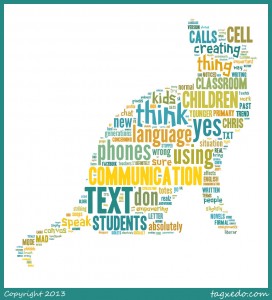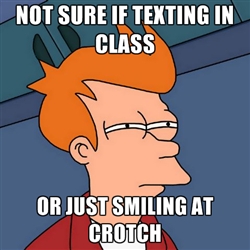Entries Tagged as 'computer-mediated communication'
First off, sorry this is so late. Apparently there is no WiFi in rural Northern Alberta, who knew?
While reading both Baron and Carrington’s articles on instant messaging and texting I felt as though the information was particularly relevant to me and my life both as a student and now as a new teacher. I remember being in high school and doing a creative English project that I called “MSN Macbeth”. Even though the class was based on creative self lead project, my teacher frowned at the project that I spent hours creating. I was reminded of this through Carringtons article where she presented the idea of, “Standard English as under attack from txting and the ‘addicts’ who use it” (Carrington 2005, 167). This is exactly how I would explain my high school English teacher’s reaction to my project. Baron’s article reiterates this idea of IMing and the language that it has created as being non academic and lesser than Standard English.
It makes sense that these articles would be relevant to me as a high school student being that they were written in 2005, but how can I relate to them now as a future teacher? Is there still a “problem” even though IMing seems to be close to being obsolete? My answer to that would definitely yes, although I do not see it as a problem at all. At first I had some trouble exploring what this new “txting” language would be, since I couldn’t see where I currently use this. As mentioned in Baron’s article, many university and college students use Standard English while instant messaging, and I believe that this has carried on into 2013, at least from my experience (Baron 2005, 130). The place where I found myself most often diverting from Standard English was in places in which I was forced to do so, mainly on the social networking site Twitter. This is when I realized a shift that has happened between the arguments of the two articles and today’s “txt talk’.
As a teenager on MSN and as a young adult nobody ever told me I had to abbreviate my language, I chose to write that was in order to be part of a group, as Baron mentions, “teens often use spoken language to express small-group identity. It is hardly surprising to find many of them experimenting with a new linguistic medium to complement the identity construction they achieve through speech, clothing, or hairstyle” (Baron 2005, 30). However, on Twitter, while I’m choosing to use the site to be part of a social networking group, I am not choosing to abbreviate my language, I am being forced to do so in order to fit into a 140 character limit. Twitter users from all walks of life, and many “academic” people use abbreviations and abbreviated hashtags everyday and nobody blinks an eye or questions their use of language. However, someone like Snooki might use “your” instead of “you’re” and the twitter grammar police will be all over her. Both of these articles lead me to question how are standards for the use Standard English have changed over the past eight years. I personally feel as though Standard English is still the norm and as a society we still have expectations about how language is used.
(Side note: it interested me that Carrington mentioned texters as “addicts” so I counted how many times I looked at my phone during a 6.5 hour car ride and 3 hours in an airport. I counted 37 and I’m sure I missed some since it has become such a regular action for me. According to a radio show that happened to come on at the time, most people check their phones 35 times a day, so I guess I really am an addict. I see a new reality show in the future).
Baron, N.S. (2005). Instant messaging and the future of language. Communications of the ACM, Vol. 48, No. 7
Carrington, V. (2005). Txting: the end of civilization (again)? Cambridge Journal of Education, Vol.48, No.7
Tags: computer-mediated communication
There are several things that I would like to reflect on after reading both Baron and Carrington’s articles. First, as both articles were published in 2005, I was very interested in discovering whether or not the issues discussed in these articles have changed over the past few years. As I read Baron’s article, I found that the issue the article addresses (using IM) seems to be a declining trend. Drawing from my own experience, I remember that using IM such as MSN was immensely popular during my early teenage years (around 2001-2007). During the past few years however, I rarely find myself using a computer program that is sole developed for the purpose of IM. I am not suggesting that IM is not a common form of communication nowadays, what I am suggesting is that IM seems to take other forms (facebook chat, skype, twitter, etc.). These new forms of CMC allow users to not only use words, but also other forms of language (image, video, audio) to communicate with other participants. In this sense, multipurpose CMC is taking over the dominance of the single-purposed IM.
Second, I am drawn to the notion of teachers “as custodians of a particular ‘correct’ version of English” (Standard English) presented in both articles (Carrington, 170). I do agree with this notion, however, I think teachers are not only the custodian of Standard English, but also a bank of resources where students can learn new ways of communication, including short hand writing like the text-language which can be very useful under certain circumstances. On the other hand, as stated in Baron’s article, teachers should ensure students use Standard English in formal settings unless the perception of Standard English changes among the society as a whole.
Last, I would like to propose a question under this topic. During my practicum, I have communicated with both my SAs through texting in a number of settings. In some occasions, they have used text-language to communicate with me. However, I have never replied them using text-language as I am not certain if it implies any notion of impoliteness. My question is that does using text-language depend on the social status of the participants? Does text-language imply any notion of impoliteness when it is used by a participant who has a lower status compared to another participant, for example, employer and employee?
Sarah Wu
Blog post #1
References
Baron, N.S. (2005). Instant messaging and the future of language. Communications of the ACM, 46(7), 30-31.
Carrington, V. (2005). Txting: the end of civilization (again)? Cambridge Journal of Education, 35(2), 161-175.
Tags: computer-mediated communication
Litextracy?
In the current digital age, texting and literacy come together to form a paradoxical relationship. While our youth are reading and writing more than ever, their various forms of electronic communication are generally disregarded as “not real writing.” We have to understand that language is constantly changing, and texting has become the written lingua franca of our youth today. In “Instant Messaging and the Future of Language,” Baron argues that linguistic and behaviour innovation often begins with adolescents (30). Real writing or not, it is an inevitable change that is accompanied by changes in educational, cultural, and social attitudes and values.
Wts wrng w/ txtin’?
There is no doubt that texting is often perceived as a corruption of language and the root cause for our youth’s degrading literacy skills. Teachers notice texting language slowly creeping into formal writing assignments. Not only does texting affect student work, it also affects student performance and work ethics in class because of the distraction.
However, pushing those thoughts aside…
AFAIC, txtin cn b a gr8 thng
We have to reconsider what literacy means. As Carrington states in “Txting: the end of civilization (again)?”, we must understand literacy today to “extend beyond the ability to encode and decode print” (172). Literacy is the ability to decode information in various formats, make meaning from it, and encode it into ideas to be communicated to others. The language of text is a register in its own right, and it is not exactly dictated by Standard English grammar and spelling rules. In the wake of constant and rapid technological advancements throughout the past century, what we are witnessing is an evolution of language. In fact, I see potential in texting for literacy development.
We as teachers should understand that because texting is a mode of communication most common to high school students today, it would be almost ridiculous to disregard and ban the cellphone. While this new technology brings on new challenges for teaching and learning, new opportunities exist as well. The most crucial thing to do is to “make certain [our students] understand the difference between creativity and normative language use” (Baron 31). We have the responsibility to hold discussions with our students on the importance of knowing our audience and how that affects the language we use when we communicate in different contexts.
L8R,
Christina (blog post #2)
Baron, N.S. (2005). Instant messaging and the future of language. Communications of the ACM, 46(7), 30-31.
Carrington, V. (2005). Txting: the end of civilization (again)? Cambridge Journal of Education, 35(2), 161-175.
Tags: computer-mediated communication · Uncategorized

Summary:
“Instant Messaging and the Future of Language” by Naomi S. Baron
This article illustrates the notion of whether or not computer-mediated communication (CMC) is affecting the use of standard English among the young generation. The author demonstrates how the use of standard English has evolved through the Middle Ages and the Renaissance to the modern days. The author also conducted a study at American University in Washington, D.C., which investigated the use of instant messaging via America Online Instant Messenger (AIM) among undergraduate students. The research suggested that “IM conversations serve largely pragmatic information-sharing and social-communication functions rather than providing contexts for establishing or maintaining group identity” (30). The author suggests that parents and educators play a significant role in ensuring the use of formal English among adolescents and that IM is unlikely to have any profound role in changing the writing standards as long as the society does not accept this form of writing as the new standard.
“Txting: the end of civilization (again)?” by Victoria Carrington
This article begins with the author’s recent interview on an Australian radio channel regarding an essay that was fully written in text-language, submitted by a 13-year-old Scottish schoolgirl. The author was asked to discuss the issue of the “legitimacy” (or not) of txt as a form of text. Consequently, the author uses discourse analysis to analyze the initial article and another article regarding texting that was published the next day. The author finds that the articles contained fearful language regarding texting, which she described as a “rhetoric of crisis” (171). The author then illustrates how teachers play an important role in keeping this “correct” version of English and that teachers “are increasingly monitored and controlled” to fit this role of guarding the use of Standard English among teenagers (169, 170). In her conclusion, she proposes that txt should not be dismissed; it is one of many texts that students should become familiar with and fluent in.
Our Standpoint:
Is texting really a threat?
-
No, texting is not a threat to the English language or to our students’ literacy.
-
Text language is just another register that students learn to use in the appropriate setting.
-
There are many different types of literacy, text literacy is one of them. Students need to be multiliterate.
-
Students should be learning and using forms of communication that are relevant to today’s technologies and ways of interacting.
-
There are many useful web tools that facilitate teacher-student discussion through texting, in which even shy students feel confident participating.
Connecting texting to Language Arts:
Discussion Questions:
- What are your thoughts towards students using texting as a form of communication with the teacher? Have you had any experience in this context?
- Is using text-language becoming a more dominant way of how children communicate these days? Do you think this will affect their use of formal language?
- Do you think teachers are the “gatekeepers” of language? Why might they be perceived this way?
- Can you think of some other ways that texting or text-language could be used in the classroom?
Activity:
- Use discussion question #2 as an example on Poll Everywhere and have everyone text in their answers.
- Transfer responses to Tagxedo.
Our result: Communication Cat 🙂
Thanks for your participation!

References:
Baron, N. S. (2005). Instant messaging and the future of language. communications of the ACM, 48(7), 29-31.
Carrington, V. (2005). Txting: The end of civilization (again)?. Cambridge Journal of Education, 35(2), 161-175.

– Christina Lee, Melanie McKenna, Dayonne Wegner, Sarah Wu
Tags: computer-mediated communication · Seminar Prompts
In Carrington’s and Baron’s articles, they discuss how the new literacy of text-messaging is perceived by society and its possible effects on language. My first thought on these two articles is that they speak far more to our society’s fear of linguistic change than they do to any actual change. The “rhetoric of ‘crisis’” (2005 p.171) that Carrington discovers in the newspaper article towards texting shows that our society still view literacy in a singular way. It seems as if people believe there is only type of literacy and if students do not master it, our civilization will collapse. In opposition to this belief, this multiliteracies course has taught us that there are many different types of literacy that students need to master, and that there are literacies that students have already mastered which serve their communication needs very well. From this point of view, it is important for teachers to be asking: “What does it mean to be ‘literate’ in contemporary economies and cultural landscapes? What kinds of texts will the students in our classrooms find it necessary to ‘read’ and manipulate and produce in order to effectively participate in civic life?” ( Carrington 2005, p.172) For teachers to condemn these modes of communication as detrimental to students’ wellbeing is to underestimate their capacities to work between and with many literacies.
Consequently, my second thought about these two articles is that becoming fluent in texting language is very important in today’s world. It is becoming more and more uncommon to call people on the phone so we need to be able to text information quickly and efficiently. If we write everything out in full sentences, it would take forever to have a text conversation. Also, on a side note, it is pretty embarrassing (for me, anyway) when someone texts you an acronym that you don’t know. It would be very interesting to know what kind of attitude business people have toward texting since blackberries have become the main mode of communication in business.
Lastly, I’m not sure why people are so afraid of texting language when university students have been writing in short-hand code for their note-taking for years and years. We can still write essays as well. It seems that Baron is right when he writes that, “IM is unlikely to play a significant role in altering writing standards—unless we as parents and educators let it” (2005 p.31). This quote raises the troubling question: are we, as teachers, the gatekeepers of new literacies and of progression and change?
– Dayonne (Blog post #2)
Baron, N.S. (2005). Instant messaging and the future of language. Communications of the ACM, 46(7), 30-31.
Carrington, V. (2005). Txting: the end of civilization (again)? Cambridge Journal of Education, 35(2), 161-175.
Tags: computer-mediated communication



